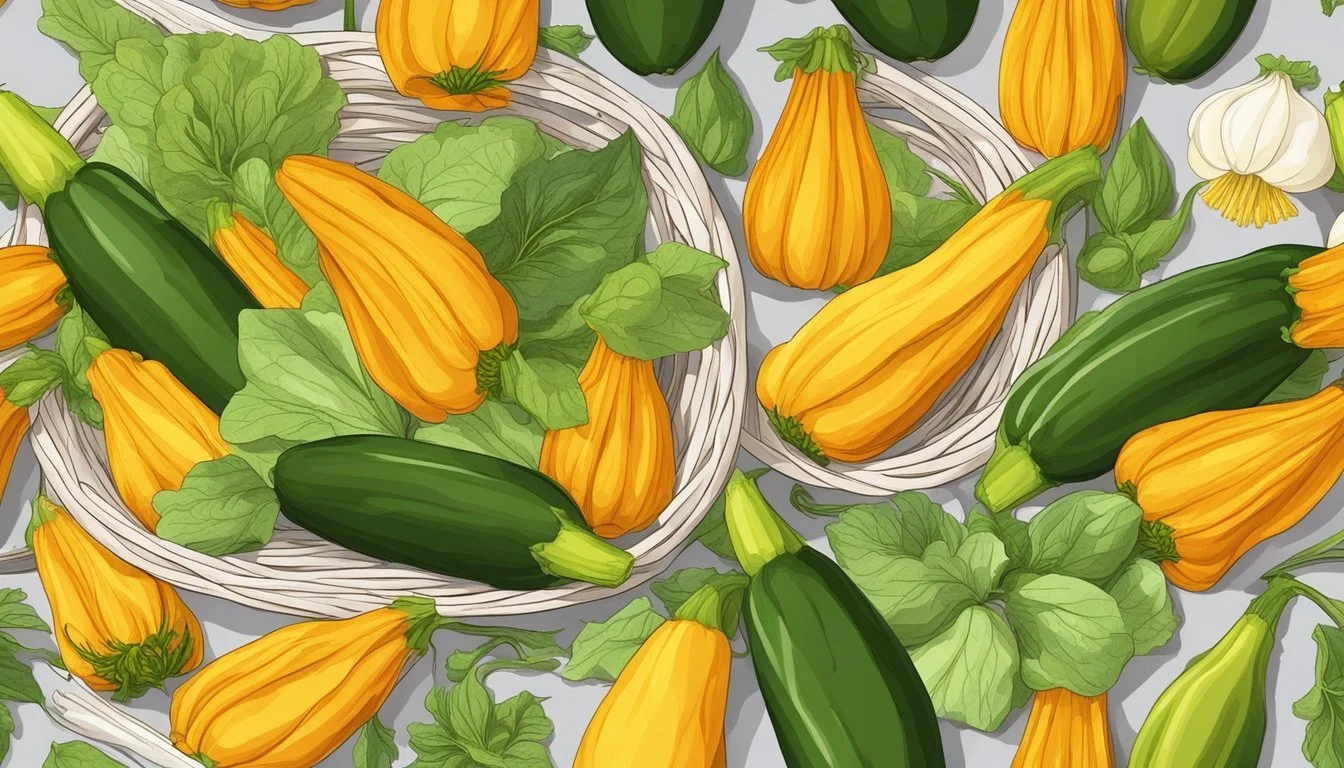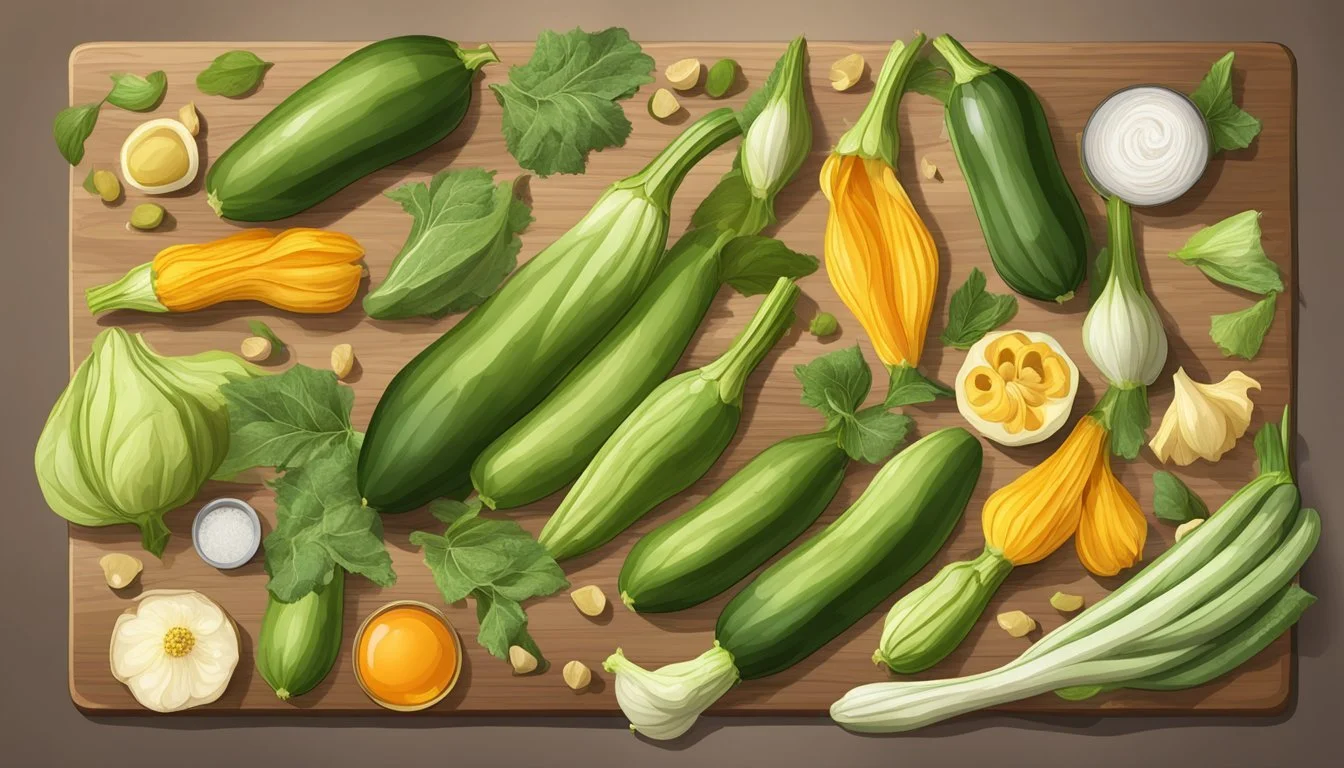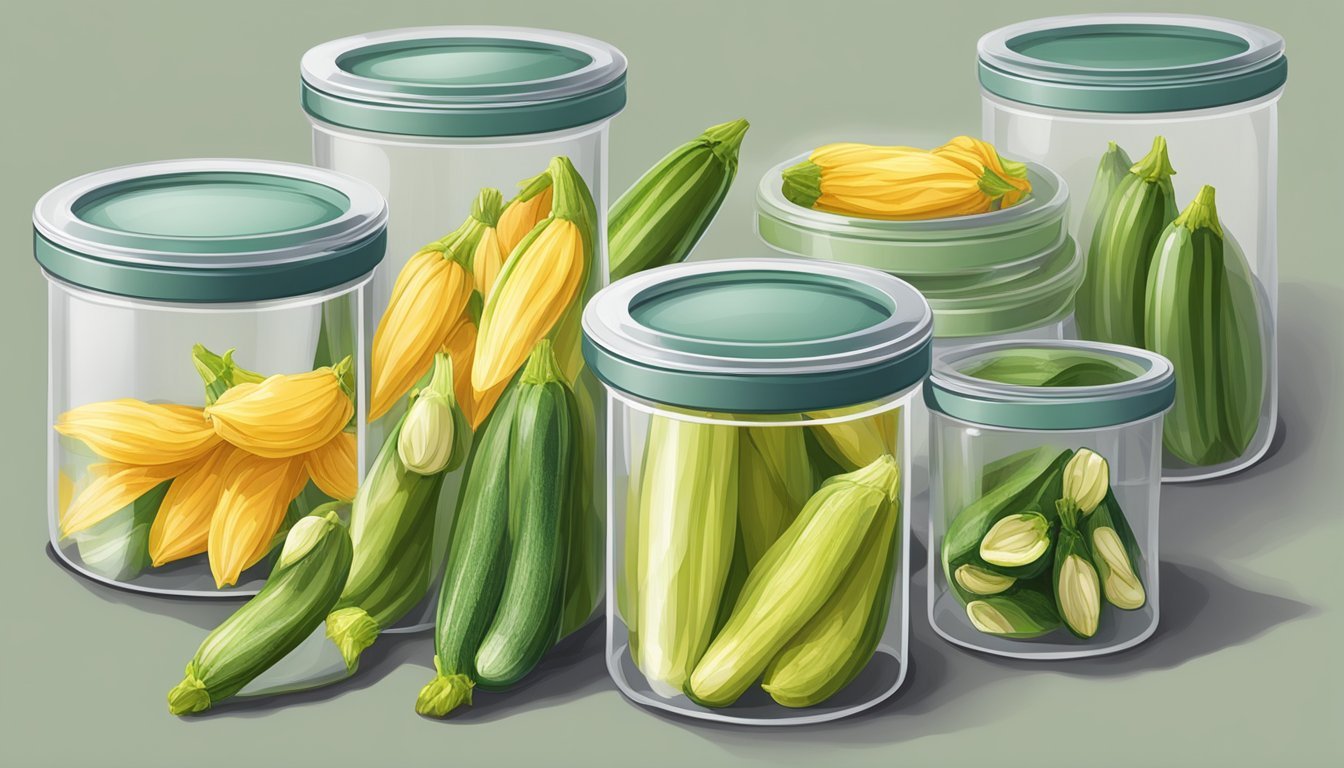Zucchini Blossoms Substitutes
Top Alternatives for Cooking
Zucchini blossoms, those delicate flowers from zucchini plants, are a prized ingredient in many gourmet dishes. These blossoms offer a unique flavor and texture, making them a favorite among chefs and home cooks alike. If you can't find zucchini blossoms at your local market, alternatives such as squash blossoms, pumpkin flowers, and nasturtium flowers can serve as excellent substitutes.
Squash blossoms are perhaps the most similar in both texture and flavor, providing a nearly identical culinary experience. Pumpkin flowers, while slightly larger, offer a comparable taste and can be used in a variety of recipes, both savory and sweet.
Nasturtium flowers add a peppery note that can invigorate your dishes, making them a versatile substitute for zucchini blossoms. Each of these options opens up new possibilities in the kitchen, ensuring that your recipes remain vibrant and delicious, even without the original ingredient.
Understanding Zucchini Blossoms
Zucchini blossoms are the edible flowers of the zucchini plant, cherished for their delicate flavor and versatile culinary applications. Knowing their unique characteristics, nutritional profile, and culinary uses can enhance one's appreciation and culinary repertoire with these blooms.
Characteristics of Zucchini Blossoms
Zucchini flowers come in male and female forms. Male flowers are more prevalent and grow on long, thin stalks. They are typically harvested for culinary use. Female flowers grow on the end of the fruit, making them less commonly used.
The blossoms have a light, slightly sweet, and squash-like flavor. Their texture is soft yet slightly crunchy, making them a versatile ingredient. Freshness is essential, so they are often picked in the morning and used the same day.
Nutritional Profile
Zucchini blossoms are low in calories but rich in essential nutrients. They contain vitamins A and C, which are beneficial for skin health and immune function. The flowers also provide a modest amount of potassium, which is crucial for heart health.
Additionally, they are a source of dietary fiber, offering digestive benefits. The blossoms' nutritional profile makes them an appealing choice for those looking to add healthy yet flavorful elements to their diet.
Culinary Uses
In cooking, zucchini blossoms can be used in various ways. They are often stuffed with cheese or meat and then fried or baked. A popular method is tempura, where the blossoms are battered and fried until golden brown.
Blossoms can also be added to salads, providing a colorful and tasty addition. Another option is incorporating them into soups and pasta dishes for enhanced flavor and texture. Their versatility in the kitchen makes zucchini blossoms a prized seasonal delicacy.
Primary Zucchini Blossom Substitutes
When zucchini blossoms are unavailable, certain squash varieties, floral alternatives, and vegetable replacements can serve as suitable substitutes. Understanding these options ensures that dishes retain their unique flavors and texture.
Squash Varieties as Substitutes
Squash blossoms from other varieties, such as summer squash and pumpkin, can replace zucchini blossoms effectively. They have a similar delicate texture and mild flavor. Summer squash blossoms are readily available during the same season as zucchini blossoms. Pumpkin blossoms offer a slightly sweeter taste but hold up well in recipes that typically use zucchini blossoms.
Selecting the right squash blossom enhances the dish without altering its essence. These blossoms can be used in stuffing, frying, or as garnishes.
Floral Alternatives
Certain edible flowers can replace zucchini blossoms. Squash blossoms remain the top choice, but others like nasturtiums, daylilies, and borage flowers can be alternatives. Nasturtiums have a peppery taste that complements salads and garnishes beautifully.
Daylilies and borage flowers provide a unique aesthetic and subtle flavors. Each flower has its own slight twist, but they don't stray too far from the delicate nature of zucchini blossoms.
Vegetable Replacements
When edible flowers are not available, some vegetables offer a practical alternative. Bell peppers and eggplants are versatile options. Bell peppers, when sliced thin, offer a crispy texture and mild taste.
Eggplants can be used in similar preparations to zucchini blossoms, like stuffing and frying. Their firm texture makes them suitable for structural dishes. These vegetable substitutes ensure that the recipe maintains its integrity while offering a different but pleasing taste.
Factors to Consider When Choosing Substitutes
Selecting a substitute for zucchini blossoms involves evaluating specific characteristics like taste, texture, and nutritional profile to ensure the alternative integrates well into your dish.
Taste and Flavor Profile
When choosing a substitute for zucchini blossoms, taste is crucial. Zucchini blossoms have a mild, slightly sweet flavor. Alternatives should harmonize with the dish's flavor profile.
For a similar taste, squash blossoms work well. Eggplant flowers and cucumber slices can be good options but might introduce more bitterness or freshness. In dishes where a sweeter note is desired, bell pepper slivers provide a nuanced flavor.
The goal is to find an ingredient that complements the other flavors without overpowering them.
Texture Compatibility
Texture plays an important role in achieving the desired culinary experience. Zucchini blossoms have a delicate, tender texture.
Squash blossoms are nearly identical in texture. Stuffed grape leaves might also be tender but offer a slightly tougher bite. Alternatively, baby spinach leaves provide a soft texture that holds fillings well. For a crispier option, bell pepper strips can add a satisfying crunch.
Matching the texture ensures that the substitute delivers a similar mouthfeel to that of the original ingredient.
Nutritional Considerations
Nutritional content is another factor. Zucchini blossoms are known for being low in calories and rich in vitamins, such as vitamin C and A.
Substitutes like squash blossoms offer similar nutritional benefits. Bell peppers are also low in calories and high in vitamins. For a higher fiber content, baby spinach is a nutrient-dense alternative. Cucumber slices provide hydration but fewer calories and nutrients compared to others.
Evaluating these aspects ensures that you maintain the health benefits the dish originally offered with zucchini blossoms.
Cooking Techniques for Substitutes
When substituting zucchini blossoms in recipes, understanding the proper preparation and cooking techniques for alternatives can ensure optimal results. Different substitutes may require different handling, so it’s essential to know the best methods for each.
Preparation Methods for Substitutes
Stuffing: Many substitutes like bell peppers and eggplants can be stuffed similarly to zucchini blossoms. To prepare, cut them in half and remove the seeds and flesh. Create a mixture of cheese, herbs, and spices, then fill the cavity.
Slicing: For substitutes like squash or cucumber, slicing thinly can mimic the tender texture of zucchini blossoms. Use a mandoline or sharp knife for uniform cuts.
Dicing: Vegetables like bell peppers and carrots can be diced for use in salads or stir-fries in place of chopped zucchini blossoms. Ensure the pieces are consistent in size for even cooking.
Cooking Tips for Optimal Results
Pan Frying: For tender substitutes like squash or eggplant, a quick pan fry can enhance flavors. Heat a small amount of oil in a pan, add sliced or diced vegetables, and cook until lightly browned and tender.
Deep Frying: Bell peppers and thicker substitutes can be deep-fried for a crispy texture similar to fried zucchini blossoms. Coat the pieces in batter, then fry them in hot oil until golden and crispy.
Baking: Stuffed substitutes like eggplant or bell peppers can be baked. Preheat the oven to 375°F, place the stuffed vegetables on a baking sheet, and cook for 20-30 minutes until they are tender and the filling is bubbling.
Seasoning: Regardless of the cooking method, season the substitutes well with salt, pepper, and other herbs to bring out their flavors. Use ingredients like garlic, parsley, and lemon juice for added zest.
Substitutes in Specific Dishes
When incorporating substitutes for zucchini blossoms in your recipes, it’s essential to consider the dish in question. Here, we explore alternatives for stuffed zucchini blossoms, salad applications, and baked goods.
Alternatives for Stuffed Zucchini Blossoms
Stuffed zucchini blossoms are a delicate dish often filled with cheese, meats, or grains. A suitable alternative would be squash blossoms, which share similar texture and flavor.
Bell peppers, cut into similar-sized pieces, can also work. They provide a different but enjoyable texture and hold fillings well.
Other possibilities include large cherry tomatoes, which offer a burst of flavor. Prep them by gently hollowing out the centers and stuffing them with your favorite ingredients.
Substitutes in Salads and Cold Dishes
When using zucchini blossoms in salads or cold dishes, the key is texture and mild flavor. Edible flowers like nasturtiums or calendula can add a similar aesthetic and subtle taste.
Alternatively, consider baby spinach leaves. While not flowers, they offer a tender bite and vibrant color.
Thinly sliced radishes provide a peppery kick. They work well for adding crunch and visual appeal to salads.
Incorporating Substitutes into Baked Goods
For incorporating substitutes into baked goods like muffins, shredded carrots are an excellent option. Their natural sweetness complements various recipes, mimicking the mild flavor of zucchini blossoms.
Diced apples can add moisture and a slight fruity note to baked dishes. They work well in sweet muffins or breads.
Grated sweet potatoes can also be used. They maintain moisture and add a unique, subtle sweetness that pairs well with spices like cinnamon and nutmeg.
Health and Dietary Considerations
When substituting zucchini blossoms, it’s essential to consider how the replacements impact health and dietary requirements, focusing on low-calorie and low-carb options, as well as allergen-friendly and vegan alternatives.
Low-Calorie and Low-Carb Options
Replacing zucchini blossoms with low-calorie and low-carb alternatives can help maintain a balanced diet. Cucumber blossoms are a great option, containing minimal calories and carbohydrates, helping individuals manage their weight and sugar intake.
Squash blossoms offer a similarly low calorie count and are rich in dietary fiber, which aids digestion. They contain essential nutrients like vitamin A and vitamin C without adding extra carbohydrates. Choosing these options ensures that dietary goals are met without sacrificing flavor or nutritional benefits.
Allergen-Friendly and Vegan Alternatives
For those with allergies or dietary restrictions, pumpkin blossoms are an excellent substitute. These flowers are not only vegan but also free from common allergens like gluten and dairy, making them suitable for a wide audience.
Edible flowers such as nasturtiums serve as another vegan-friendly option, providing vibrant color and a peppery taste without introducing any animal products or allergens. These alternatives tend to have low sodium and saturated fat content, which is beneficial for heart health.
Using these substitutes ensures that those with dietary preferences or restrictions can still enjoy delicious and nutritious meals.
Preservation and Storage of Substitutes
Proper preservation and storage techniques are crucial to ensure that zucchini blossom substitutes maintain their flavor and quality. Focusing on freshness and long-term storage methods will help in achieving the best results.
Keeping Substitutes Fresh
To keep substitutes like squash, eggplant, and cucumber fresh, start by thoroughly washing them in cold water. Pat dry with a paper towel to remove excess moisture. For short-term storage, wrapping the vegetables in a slightly damp paper towel helps in retaining moisture and placing them in a perforated plastic bag in the refrigerator can extend their freshness. Vegetables like eggplant and squash should ideally be stored in the vegetable crisper drawer, which has a controlled humidity environment, crucial for maintaining their texture and flavor.
Long-Term Storage Techniques
For extended preservation, consider techniques like freezing or pickling. Blanching vegetables, which involves briefly boiling them and then plunging them into ice water, can help retain texture and flavor before freezing.
To freeze, slice the vegetables, blanch, and store them in airtight containers or zip-top bags. For pickling, submerge the vegetables in a brine solution of water, vinegar, and salt. Place in sterilized glass jars and ensure they're tightly sealed.
Small eggplants can be roasted with olive oil and then frozen for later use, which enhances their flavor and provides a convenient way to add a rich taste to dishes.
Conclusion
Zucchini blossoms offer a unique texture and flavor in culinary dishes. When substitutes are needed, options like squash blossoms, pumpkin blossoms, and even daylilies can be excellent alternatives.
Squash blossoms are commonly available and share a similar taste and texture to zucchini blossoms. They're versatile and easy to use in recipes like fritters and stuffed dishes.
Pumpkin blossoms are another good choice. They have a slightly sweet flavor and can be used in similar ways to zucchini blossoms, adding a touch of sweetness to the dish.
Daylilies can serve as an unconventional but effective substitute. They have a sweet and slightly peppery taste, making them a flavorful addition to salads and garnishes.
Pro Tip: Always use blossoms fresh and make sure they are clean and free of pesticides.
When substituting zucchini blossoms, consider the flavor profile and texture of the dish. This ensures a seamless replacement that maintains the dish's intended taste and structure.
Using these substitutes can help diversify your dishes while still retaining the delicate essence of zucchini blossoms.







